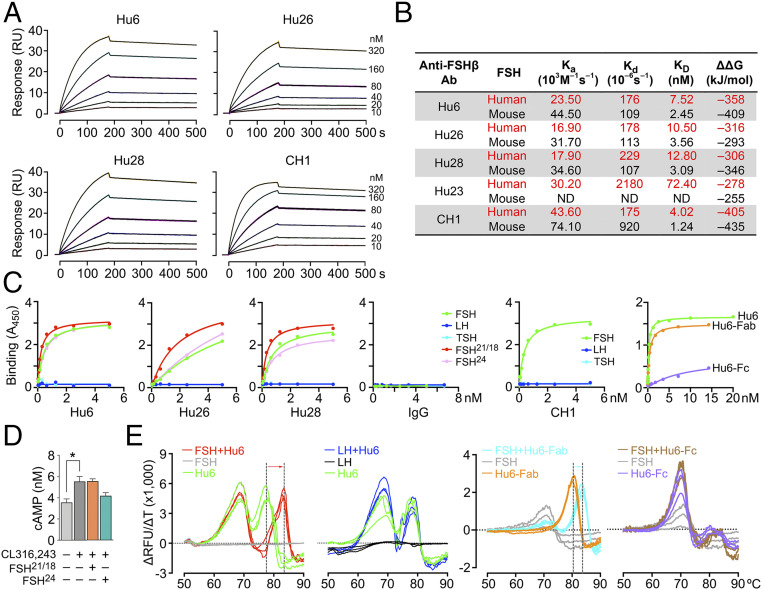Fig. 1.
Humanized anti-FSHβ antibodies specifically bind human FSH. Surface plasmon resonance (SPR, Biacore 8K/T200) was utilized to study the binding properties of human and mouse FSH with the purified humanized antibodies Hu6, Hu26, Hu28, and Hu23, as well as human–mouse chimeric molecule CH1. (A) Sensograms showing the concentration-dependent binding of humanized antibodies Hu6, Hu26, and Hu28 (10 to 320 nM) to human FSH. (B) SPR yielded measures of association constant (Ka), dissociation constant (Kd) and affinity (KD). The KD values were consistent with in silico global net electrostatic binding energies (DDG) calculated from molecular dynamics using APBS. Hu6 displayed the highest KD and lowest Kd and was thus chosen as the lead molecule for development. ND – not determined. Please also refer to SI Appendix, Fig. S3. (C) ELISA showing binding of Hu6, Hu6-Fab, Hu26, Hu28, or CH1 to pituitary-derived human FSH and its recombinant glycoforms, FSH21/18 and FSH24, but not to human LH, human TSH (coating at 50 ng), or Hu6-Fc detected with HRP-conjugated antibody to human IgG. There is no binding with human IgG. Data are a mean of duplicate wells. (D) cAMP production in differentiated 3T3.L1 cells incubated with FSH21/18 or FSH24 in the presence of the β3 agonist CL316,243 (n = 3 biological replicates). (E) Protein thermal shift assay utilizes Sypro-Orange to capture hydrophobic domains during heat-induced protein unfolding to yield a melting temperature (Tm). Change in fluorescence is shown as relative fluorescence units (ΔRFU) per unit change in temperature (ΔT). Hu6 showed two peaks: one at ∼69 °C, predicted to be caused by unfolding of the Fc domain, and the other at 77 °C, likely due to unfolding of Fab region. The addition of human FSH, but not human LH, produced a thermal shift solely in the putative Fab peak. Binding of FSH to the Fab domain was confirmed by a comparable thermal shift in Hu6-Fab, but not Hu6-Fc, in the presence of FSH.

